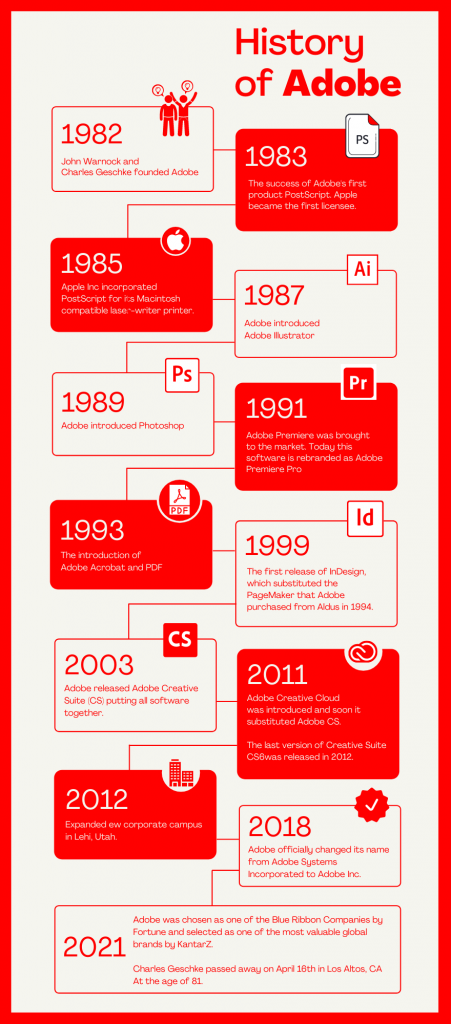Adobe Inc, formerly known as Adobe System Incorporated, is a popular design, printing, and publishing software developer founded in 1982.
Started out with its first desktop publishing product Postscript in 1983, today it’s known for providing creative solutions for advertising, marketing, and visual communication. From image manipulation to video animation, Adobe has a designed program to meet the needs.
Some of Adobe’s popular products like Illustrator and Photoshop are rated as the best design tools by many designers. The introduction of Adobe Acrobat and PDF was also a game-changer in the digital publishing industry.
Let’s take a quick tour of the history of Adobe via this infographic I designed.
Table of Contents
Founding
Adobe Inc was founded by John Warnock and Charles Geschke, former employees of Xerox.
The company is named after a place called Adobe Creek in Los Altos, California and its headquarter is located in San Jose, California.
The Adobe founders met at Xerox’s research center while they were developing a programming language that can describe the precise position, shapes, and size of objects on a computer screen page. In other words, translating images and text on a computer to print.
John Warnock and Charles Geckche wanted to show this technology to the world, however, Xerox declined, and that’s how they decided to start their own business (Adobe) to bring this desktop publishing technology to the market.
Adobe’s first logo was designed by Marva Warnock, John Warnock’s wife, who was also a graphic designer.

Over the years, Adobe simplified and modernized the logo, and today Adobe’s logo is better representing the brand and very recognizable.

History & Development
Soon after the founding of Adobe, the desktop publishing technology known as PostScprit became a huge success. In 1983, Apple became the first company to get a PostScript license, and two years later in 1985, Apple Inc incorporated PostScript for its Macintosh compatible laser-writer printer.
Publishing can’t live without fonts/typefaces. Adobe started to develop different types of fonts after seeing the success of PostScript for both Apple and Microsoft users. Adobe reported making $100 million a year in printer software and font licensing.
Soon after, Apple and Adobe had disagreements on the type licensing fees which caused the font wars in the late 1980s. Apple teamed up with Microsoft trying to sell Adobe stock and develop their own font-rendering technology called TrueType.
While handling the situation of the font wars, Adobe continued focusing on desktop software development.
Software Development
In 1987 Adobe introduced Adobe Illustrator, software for creating vector graphics, drawings, posters, logos, typefaces, presentations, and other artworks. This vector-based program is widely used by graphic designers internationally. At the same time, Adobe also released Type Library.
Another big moment for Adobe was when it introduced Photoshop two years later. This image manipulation software application very soon became the most popular and successful Adobe program worldwide.
During this time, Adobe really put effort into developing new applications for creative work. In 1991, Adobe Premiere, an essential tool for motion graphics, video editing, and multimedia production was brought to the market, taking design to the next level.
To better enhance the viewing of digital publishing and solve the problem of file sharing for different computer systems, in 1993, Adobe Acrobat (PDF) was introduced. It delivers the image from the design software to a digital document and allows you to view the original form of text and graphics electronically when it’s saved as Acrobat or PDF.
In 1994, Adobe acquired Aldus, a software company that developed PageMaker, later substituted by InDesign, first released in 1999.
InDesign is considered an upgraded version of PageMaker, software for layout publishing. Today is popularly used for portfolios, brochures, and magazine designs.
Just like every business, Adobe also had its ups and downs. While Adobe was expanding, it purchased different software to develop. During the mid-1990s to early 2000s, Adobe faced some challenges because some of the software it purchased didn’t meet its expectations and caused a heavy decline in sales.
The situation got better after InDesign was released, which boosted its sales first time in its history to more than $1 billion. Since then Adobe has come to a new era.
In 2003, Adobe released Adobe Creative Suite (CS) putting all software together including Photoshop, Illustrator, InDesign, Premiere Pro, etc to unify the brand and consistently update the programs. In the same year, Adobe rebranded Adobe Premiere as Adobe Premiere Pro and acquired some other media editing software such as Cool Edit Pro.
In the next couple of years, Adobe was trying to develop more creative programs to include in the Adobe Creative Suite. Adobe acquired its main competitor Macromedia in 2005 along with other software.
During that time, Dreamweaver, a web design tool, and Flash, an interactive media production tool were added to Adobe Creative Suite.
In 2006, Adobe introduced Adobe Youth Voices to help young creatives to express themselves and share their creativities.
In the same year, Adobe became the first commercial enterprise to receive three Platinum certifications in the world. From the United States Green Building Council USGBC, under the Leadership in Energy and Environmental Design LEED -Existing Building Program for its facilities in San Jose.
Adobe Media Play was introduced in 2008 and soon it became a competitor for Apple iTunes, Windows Media Player, etc. Adobe Media Player was designed for playing video and audio files on computers and later it was adopted by several TV networks.
As everything goes toward the web, in 2011, Adobe released the first version of Adobe Creative Cloud. Similar to the Creative Suite, it’s a set of creative tools for design, web publishing, video production, etc. The biggest difference is that Adobe CC is a subscription program and you can save your work in the cloud storage.
The last version of CS was released in 2012, known as CS6. In the same year, Adobe expanded a new corporate campus in Lehi, Utah.
In October 2018, Adobe officially changed its name from Adobe Systems Incorporated to Adobe Inc.
Today
Adobe Inc has gained industry recognition and chosen as one of the Blue Ribbon Companies by Fortune. Today Adobe has over 24,000 employees worldwide, and by the end of 2020, it reported its 2020 fiscal revenue of US$12.87 billion.
References
- https://www.adobe.com/about-adobe/fast-facts.html
- https://courses.cs.washington.edu/courses/csep590/06au/projects/font-wars.pdf
- http://www.fundinguniverse.com/company-histories/adobe-systems-inc-history/
- https://www.britannica.com/topic/Adobe-Systems-Incorporated


Rajesh
The best graphics suite available in media and advertising industry
Zoe C.
Amazing timeline! im taking adobe classes and this really helped! adobe is amazing!
June Escalada
Hey Zoe,
Oh! Definitely! I love Adobe.
Enjoy the learning journey!